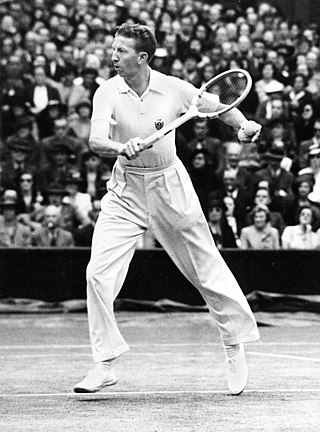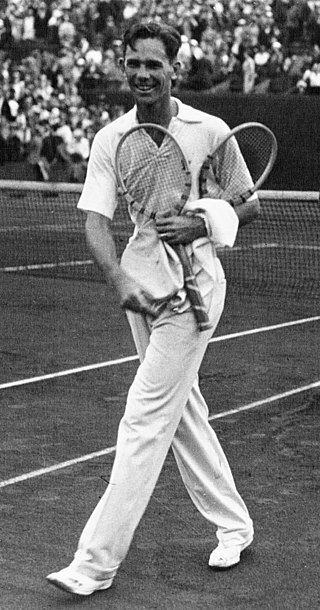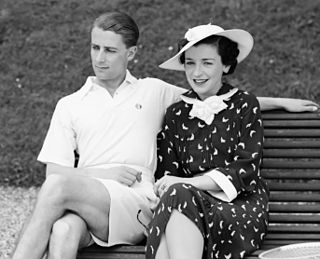
John Donald Budge was an American tennis player. He is most famous as the first tennis player — male or female, to win all four Grand Slam events consecutively overall. Budge was the second man to complete the career Grand Slam after Fred Perry, and remains the youngest to achieve the feat. He won ten majors, of which six were Grand Slam events and four Pro Slams, the latter achieved on three different surfaces. Budge is considered to have one of the best backhands in the history of tennis, with most observers rating it better than that of later player Ken Rosewall.

Frederick John Perry was a British tennis and table tennis player and former world No. 1 from England who won 10 Majors including eight Grand Slam tournaments and two Pro Slams single titles, as well as six Major doubles titles. Perry won three consecutive Wimbledon Championships from 1934 to 1936 and was World Amateur number one tennis player during those three years. Prior to Andy Murray in 2013, Perry was the last British player to win the men's Wimbledon championship, in 1936, and the last British player to win a men's singles Grand Slam title, until Andy Murray won the 2012 US Open.

Lewis Alan Hoad was an Australian tennis player whose career ran from 1950 to 1973. Hoad won four Major singles tournaments as an amateur. He was a member of the Australian team that won the Davis Cup four times between 1952 and 1956. Hoad turned professional in July 1957. He won the Kooyong Tournament of Champions in 1958 and the Forest Hills Tournament of Champions in 1959. He won the Ampol Open Trophy world series of tournaments in 1959, which included the Kooyong tournament that concluded in early January 1960. Hoad's men's singles tournament victories spanned from 1951 to 1971.

John Albert Kramer was an American tennis player of the 1940s and 1950s, and a pioneer promoter who helped drive the sport towards professionalism at the elite level. Kramer also ushered in the serve-and-volley era in tennis, a playing style with which he won three Grand Slam tournaments. He also led the U.S. Davis Cup tennis team to victory in the 1946 and 1947 Davis Cup finals.

Henry Ellsworth Vines Jr. was an American tennis champion of the 1930s, the World No. 1 player or the co-No. 1 in 1932 as an amateur, and in 1934, 1935, 1936 and 1937 as a professional. He won three Grand Slam titles, the U.S. National Championships in 1931 and 1932 and the Wimbledon Championships in 1932. Vines also was able to win Pro Slam titles on three different surfaces. He later became a professional golfer and reached the semifinals of the PGA Championship in 1951.

Adrian Karl Quist was an Australian tennis player.

Frank Andrew Parker was an amateur & later professional American male tennis player of Polish immigrant parents who was active in the 1930s and 1940s. He won four Grand Slam singles titles as well as three doubles titles.

Henry Wilfred "Bunny" Austin was an English tennis player. For 74 years he was the last Briton to reach the final of the men's singles at Wimbledon, until Andy Murray did so in 2012. He was also a finalist at the 1937 French Championships and a championship winner at Queen's Club. Along with Fred Perry, he was a vital part of the British team that won the Davis Cup in three consecutive years (1933–35). He is also remembered as the first tennis player to wear shorts.

Heinrich Ernst Otto "Henner" Henkel was a German tennis player during the 1930s. His biggest success was his singles title at the 1937 French Championships.

Robert Larimore Riggs was an American tennis champion who was the world No. 1 amateur in 1939 and world No. 1 professional in 1946 and 1947. He played his first professional tennis match on December 26, 1941.
Franjo Kukuljević was a Yugoslav tennis player. He played for the Yugoslavian team at the International Lawn Tennis Challenge from 1930 to 1939. He was a 13-time national champion – one in singles, six in doubles and six in the mixed doubles, usually with Vlasta Gostiša. He was a Dutch, Indian and Danish champion as well.

Pierre Pellizza was a French tennis player in the years before and after World War 2. In 1948 he settled in America. His younger brother was tennis and badminton player Henri Pellizza. Allison Danzig of The New York Times said of Pierre Pellizza: "Pellizza was a bulldog for tenacity. He showed a forehand that rivalled Petra's...and a backhand that excelled his countryman's". The best results of Pierre Pellizza's career came at Monte Carlo, where he won the title in 1939 and 1946. Pellizza played Davis Cup from 1938 to 1947.
Abel Kay (1911–2004) was an Australian tennis player. He was renowned for his fitness and played several sports to a good standard. As a boxer he was Victorian amateur welterweight champion in 1931. He also played football and water polo. Entering the Australian Championships for the first time in 1933, Kay lost in round one to Wilmer Allison. The following year he lost his first match to Harry Lee in five sets. In 1935 he lost his first match to Enrique Maier. In 1936 Kay reached the semi-finals. The following year he lost to Vivian McGrath in the quarter-finals. In 1939 he lost in round one to James Gilchrist.
Giovanni Cucelli was an Italian tennis player. He played Davis Cup for Italy and formed a great doubles partnership with Marcello Del Bello. Because of World War 2, Cucelli was 30 by the time he made his Grand Slam debut at Wimbledon in 1947, where he lost in the third round to Jack Kramer. At Roland Garros Cucelli beat veteran Jack Crawford and Robert Abdesselam before losing to defending champion Marcel Bernard in five sets in the quarter-finals. At Roland Garros in 1948, Cucelli beat a young Frank Sedgman before losing to Frank Parker in the quarter finals. At Wimbledon Cucelli beat Jaroslav Drobny before losing to Tony Mottram in round three. At Roland Garros in 1949, Cucelli reached his third consecutive quarter-final, where he lost to Budge Patty. At Wimbledon he beat Mottram before losing to Eric Sturgess in the last 16. At 1949 U.S. Championships, Cucelli lost in the second round to Sam Match. Cucelli lost in the last 16 of Roland Garros in 1950 to Patty. After early exits at the French and Wimbledon in 1951, Cucelli reached the last 16 at Roland Garros in 1952, where he lost to Ken McGregor. He lost early at Wimbledon to Mottram. Cucelli lost his first match at Roland Garros in 1953 to Rex Hartwig. In 1955 Cucelli turned professional. Cucelli won a lot of tournaments during his career: Italian Riviera championships and Alassio in 1939, Napoli and Barcelona Christmas tournament in 1941, St. Moritz, French-Switzerland championships and Milan international in 1946, Swiss championships, Villars, Montana-Vermala, Viareggio and Rapallo in 1947, Milan international, Napoli, Rapallo, Montecatini and Barcelona Christmas tournament in 1948, San Remo in 1949, Lugano, Istanbul, Venice and Lugano Lido tournament in 1950, San Pellegrino and Viareggio in 1951 and Cava De Tirreni in 1952. He was runner-up at Monte Carlo in 1948 to Jozsef Asboth and 1949 to Parker and runner-up at Rome in 1951.
Jack Clemenger (1899–1964) was an Australian tennis player. He began his career in New South Wales and then moved to Victoria. In business he rose to the rank of general sales manager at Allied motors in Australia. While studying at Sydney University, Clemenger played baseball, billiards, cricket and rugby, but it was at tennis he most excelled. He had a good all round game and was better at doubles than singles. Clemenger made his debut at the 1919 Australasian championships and lost in round three to James Anderson. At the 1922 championships, Clemenger lost in the quarter-finals to Norman Peach. In 1924 he lost in round one to Garton Hone. In 1930 he lost in the quarter-finals to Harry Hopman. At Wimbledon in 1932, Clemenger lost in five sets in round three to Paul Féret. At the 1933 Australian championships, Clemenger lost in round two to Keith Gledhill. At the 1935 Australian championships, Clemenger beat Jacques Brugnon before losing to Giorgio de Stefani in round three. In 1939 he lost in round one to Colin Long. Clemenger was an Australian Davis Cup captain and selector. He started Clemenger Advertising in 1946 and was awarded the OBE.
Maxwell Harry Bonner (1917–1996) was an Australian tennis player. He was originally from Western Australia, but moved to Victoria in the 1940s. He was singles champion of Western Australia in 1941. He began playing tennis at an early age, as his parents were told to make sure he went outside for health reasons. Aged 23 in September 1940, Bonner became a sergeant in the R. A. A. F. After serving in the Darwin raids, he was discharged on medical grounds. He was a popular player and very agile around the court, but was prone to being erratic. Bonner made his debut at the 1936 Australian championships and lost in round one to Lionel Brodie. In 1937 he lost in round one to Frank Bennett. In 1938 he lost in round one to Adrian Quist. In 1939 he lost in round two to Vivian McGrath. In 1940 he lost in round two to Bill Sidwell. At the Australian championships in 1946, Bonner had the best win of his career against veteran former champion Jack Crawford. The match contained many long gruelling baseline rallies and in the end Bonner wore out his older opponent. Bonner then lost to Quist in the quarter-finals. In 1947 he lost in round two to Brodie. In 1948 and 1949 he lost early to Sidwell. Then Bonner became a professional tennis coach.
James Gilchrist was an Australian tennis player. He was reaching his peak just as World war 2 broke out. After serving in the war, Gilchrist resumed his career. Gilchrist had a good serve and powerful forehand, but a weak backhand, though he worked hard to improve it. Gilchrist won several tournaments, but at the Australian championships he often lost to Bromwich or Quist, the two best Australian players of that era. Gilchrist made his Grand Slam debut at 1936 Australian championships and lost in round two to Adrian Quist. In 1938 he lost in round two to John Bromwich. In 1939 he reached the quarter-finals and lost to Jack Crawford in five sets. At the Australian championships in 1940, Gilchrist beat Jack Cummings before losing to Quist in round two. In 1947 he lost in round two of the Australian championships to Bromwich. In 1951 he lost in the second round to Quist.
Harry Hassett (1905–1971) was an Australian tennis player. He was the brother of cricket legend Lindsay Hassett and was a fine cricket all-rounder himself, but tennis took priority over cricket for Harry. Sporting Globe described Hassett's tennis game by saying he was "sound in all departments of the game except his second serve, which is decidedly weak, and strong physically". Hassett had a great backhand. Hassett made his debut at the Australian championships in 1930 and lost in five sets to Harry Hopman in round three. In 1931 he lost in the quarter finals to Jack Cummings. In 1933 he took the first set from top seed Ellsworth Vines but lost in four sets in round two.
Alan Coldham (1906–1996) was an Australian tennis player who later settled in England. He also played golf.
Ian McInnes (1901–1977) was an Australian tennis player. He was also a medical doctor. At the 1923 U.S. Championships, McInnes lost in the second round to Manuel Alonso Areizaga. At the 1924 Australasian championships, McInnes caused a huge upset by beating two-time Wimbledon champion Gerald Patterson. Patterson twisted his ankle in the first set and, because of this, his game was affected and he played mainly from the baseline. McInnes lost in the quarter-finals to Richard Schlesinger. McInnes lost in the second round of the 1927 Australian championships to Rice Gemmell In 1967 McInnes attended Gerald Patterson's funeral.










